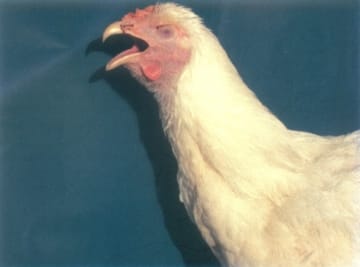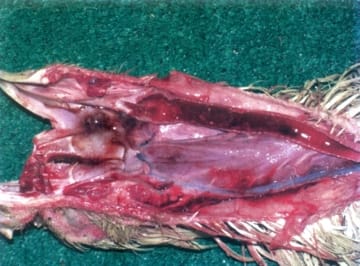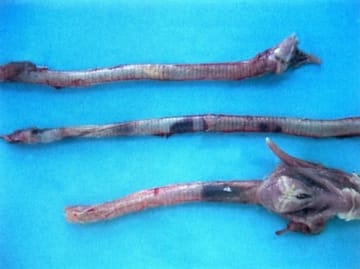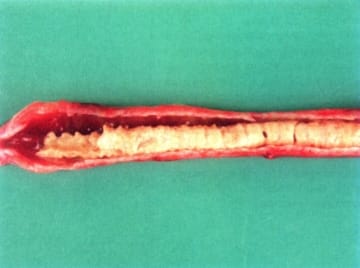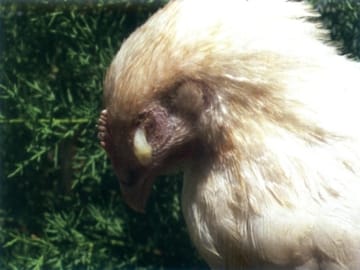LT is a viral infection in hens, pheasants and paecocks characterized by catarrhal haemorrhagic to fibrinous inflammation of the respiratory tract. It is manifested in laryngotracheal form, suffocation, rales and cough are observed. The head and the neck are strongly extended forward and upward during inspiration (Image 1).
Image 1 The head and the neck are strongly extended forward and upward during inspiration
The mucous coats of the larynx and the trachea are catarrhally haemorrhagically to fibrinously inflamed (Image 2).
Image 2 Haemorrhage and inflammation in the larynx and the trachea
Haemorrhagic laryngotracheitis (Image 3).
Image 3 Haemorrhagic laryngotracheitis
Most outbreaks are encountered between the age of 4 and 14 weeks although the disease affects fowl of any age. LT is caused by a herpesvirus that is relatively resistant.
The morbidity rate of LT reaches 50 - 70% and the death rate: 10 - 20%. Often, it goes on as a complicated infection after the involvement of E. coli, Staphylococcus aureus, Mycoplasma gallisepticum, etc.
In some cases, casts of haemorrhagic or fibrinous exudate are formed that could almost completely obturate the larynx and the trachea (Image 4).
Image 4 Fibrinous exudate almost obturate the larynx and the trachea
Source of the infection are sick and convalescent birds, the latter being prolonged carriers of the virus (up to 1 - 2 years).
In the conjunctival form of LT, wet eyes, tear secretion and oedema of infraobital sinuses are observed (Image 5), especially in a complicated infection.
Image 5 Oedema of infraobital sinuses
The typical clinical and morphological signs are sufficient to assume the presence of LT. The diagnosis is confirmed with the detection of intranuclear inclusion bodies in the trachea throughout the histological study in the early stages of the disease, serological studies (VN, ELISA) etc.
LT should be differentiated from IB, SHS (swollen head syndrome), Mycoplasma synoviae infections, etc.
Premises, contamined with the LT virus, should be freed, cleansed, disinfected and occupied again after 5 - 6 weeks. The vaccination of unaffected birds and these from other premises of the infected farm could protect and stop subsequent outbreaks.
(Source: "Diseases of poultry - A colour atlas" - Ivan Dinev & CEVA Santé Animal, 2010)
.
Related topics: disease technical information poultry infectious laryngo tracheitis

 Corporate Website
Corporate Website
 Africa
Africa
 Argentina
Argentina
 Asia
Asia
 Australia
Australia
 Belgium
Belgium
 Brazil
Brazil
 Bulgaria
Bulgaria
 Canada (EN)
Canada (EN)
 Chile
Chile
 China
China
 Colombia
Colombia
 Denmark
Denmark
 Egypt
Egypt
 France
France
 Germany
Germany
 Greece
Greece
 Hungary
Hungary
 Indonesia
Indonesia
 Italia
Italia
 India
India
 Japan
Japan
 Korea
Korea
 Malaysia
Malaysia
 Mexico
Mexico
 Middle East
Middle East
 Netherlands
Netherlands
 Peru
Peru
 Philippines
Philippines
 Poland
Poland
 Portugal
Portugal
 Romania
Romania
 Russia
Russia
 South Africa
South Africa
 Spain
Spain
 Sweden
Sweden
 Thailand
Thailand
 Tunisia
Tunisia
 Turkey
Turkey
 Ukraine
Ukraine
 United Kingdom
United Kingdom
 USA
USA
 Vietnam
Vietnam

